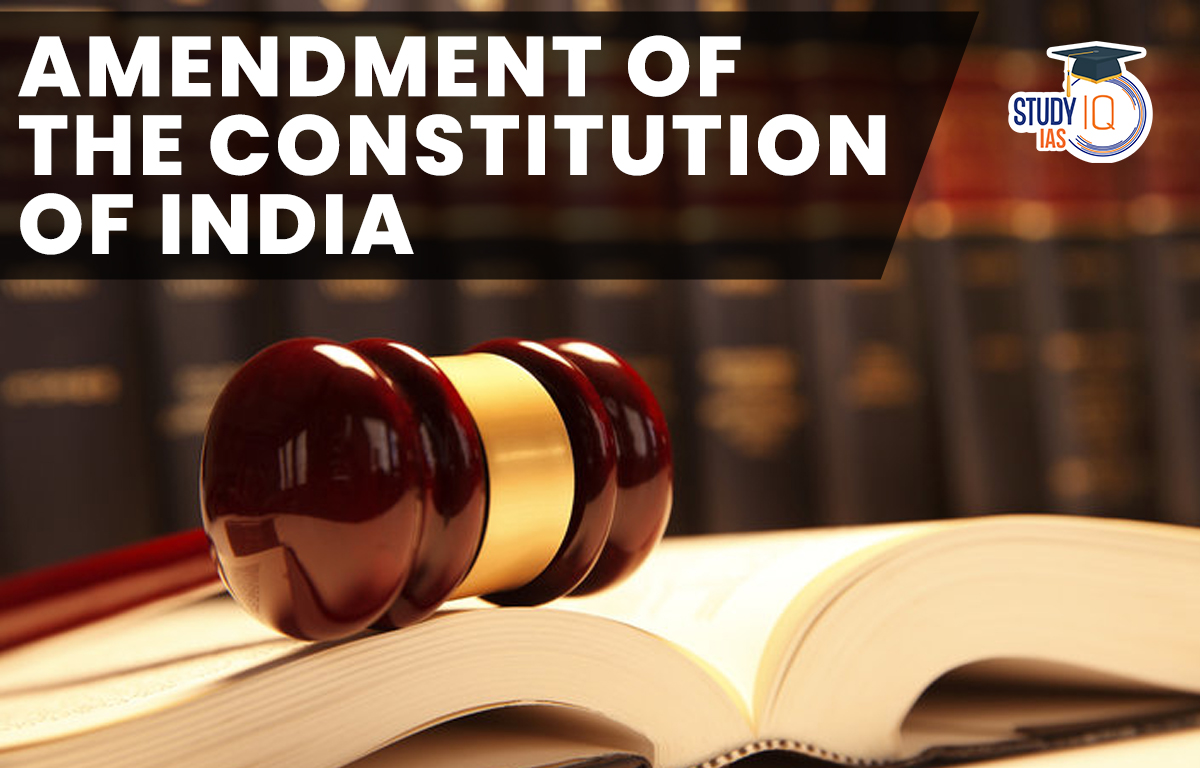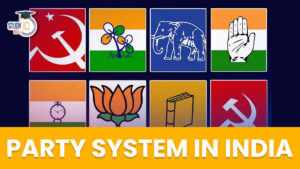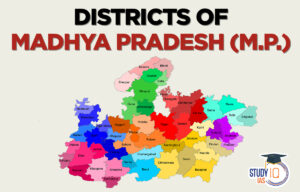Table of Contents
Amendment of the Constitution of India
Amendment of the Constitution of India means the process of making changes to the Constitution. The parliament has the authority to change the constitution under Article 368 of Part XX. The best way to understand the nature of the constitutional amendment process is to use Pandit Nehru’s insight that the Constitution shouldn’t be so rigid that it can’t be modified to meet changing requirements for national progress and strength.
In this article, we will discuss the Amendment of the Constitution of India which is an important topic of Polity subject of the UPSC Syllabus. Students can also go for UPSC Mock Test to get more accuracy in their preparation.
Amendment of the Constitution of India and Provision
The Amendment of the Constitution of India is a process that is neither as simple as that in Britain (which has no written constitution and is based on convention) nor as challenging as that in the USA. The Indian Constitution is a mix of both flexibility and rigidity. The power of Parliament to modify the Constitution and its process are covered in Section 368 of Part XX of the Constitution. The method for amending the constitution is taken from the South African constitution.
The only body with the authority to modify the constitution is Parliament. According to the Supreme Court’s decision in the Kesavananda Bharati case, Parliament cannot modify the clauses that make up the fundamental framework of the constitution. (1973). There is no provision in Article 108 for a joint session in the event that both chambers of Congress disagree on a constitutional amendment bill. The president’s permission is not necessary in advance for the presentation of a constitutional change measure.
Procedure to Amend the Indian Constitution
To amend the Constitution, the process is as follows:
- Initiation: A bill to amend the Constitution can be introduced in either house of Parliament by a minister or a private member, without needing the President’s prior permission.
- Approval: The bill must be passed by a special majority in both houses. This means it needs a majority of the total members and two-thirds of those present and voting.
- Separate Voting: Each house must vote on the bill separately, and there’s no joint sitting for disagreements.
- Ratification: If the amendment affects certain provisions, it must also be approved by at least half of the state legislatures with a simple majority.
- Presidential Assent: Once passed by both houses, the bill goes to the President, who must give his assent. The President cannot refuse or return the bill.
- Final result: After the President’s assent, the bill becomes a constitutional amendment act.
Ways to Amend the Constitution
By Simple Majority of Parliament: This means more than 50% of members present and voting can amend certain articles without a special procedure. Examples include:
- Article 2 (new states)
- Fifth Schedule (Scheduled Areas)
- Citizenship laws
- Elections to Parliament and state legislatures.
By Special Majority of Parliament: This requires a majority of the total membership of each House and two-thirds of those present and voting. Examples include:
- Fundamental Rights
- Directive Principles of State Policy.
Also, some amendments need both a special majority in Parliament and ratification by half of the state legislatures, like the election of the President and provisions in the Seventh Schedule.
Amendment of the Constitution of India List
Since its creation in 1950, the Indian Constitution has had 104 revisions as of January 2020.
| S. No. | Amendments in the Constitution | Description |
| 1 | First Amendment Act, 1951
|
|
| 2 | Constitutional (13th Amendment) Act,1963 |
|
| 3 | Constitutional (15th Amendment) Act, 1963
|
|
| 4 | The Constitution (24th Amendment) Act, 1971
|
|
| 5 | The Constitution (36th Amendment) Act, 1975 |
|
| 6 | The Constitution (42nd Amendment) Act, 1976 |
|
| 7 | The Constitution (43rd Amendment) Act, 1978 |
|
| 8 | The Constitution (44th Amendment) Act, 1978 |
|
| 9 | The Constitution (52nd Amendment) Act, 1985 |
|
| 10 | The Constitution (61st Amendment) Act, 1989 |
|
| 11 | The Constitution (66th Amendment) Act, 1990 |
|
| 12 | The Constitution (69th Amendment) Act, 1991 |
|
| 13 | The Constitution (70th Amendment) Act, 1992
|
|
| 14 | The Constitution (73rd Amendment) Act, 1992
|
|
| 15 | The Constitution (74th Amendment) Act, 1992 |
|
| 16 | The Constitution (78th Amendment) Act, 1995 |
|
| 17 | The Constitution (81st Amendment) Act, 2000
|
|
| 18 | The Constitution (83rd Amendment) Act, 2000
|
|
| 19 | The Constitution (85th Amendment) Act, 2001
|
|
| 20 | The Constitution (86th Amendment) Act, 2002 |
|
| 21 | The Constitution (87th Amendment) Act, 2003
|
|
| 22 | The Constitution (89th Amendment) Act, 2003
|
|
| 23 | The Constitution (91st Amendment) Act, 2004
|
|
| 24 | The Constitution (93rd Amendment) Act, 2006
|
|
| 25 | The Constitution (94th Amendment) Act, 2006
|
|
| 26 | The Constitution (97th Amendment) Act, 2012
|
|
| 27 | The Constitution (99th Amendment) Act, 2014 |
|
| 28 | The Constitution (100th Amendment) Act, 2015
|
|
| 29 | The Constitution (101th Amendment) Act, 2017 |
|
| 30 | The Constitution (102th Amendment) Act,2018 |
|
| 31 | The Constitution (103th Amendment) Act,2019 |
|
| 32 | The Constitution (104th Amendment) Act, 2020 |
|
Limitations on Parliament’s Amending Power
The Parliament’s power to amend the Constitution is limited by the Basic Structure doctrine, established by the Supreme Court in the Keshavananda Bharati case (1973). This means that amendments cannot alter the Constitution’s fundamental features.
Court cases that highlight these limitations include:
- Minerva Mills vs. Union of India (1980): The Supreme Court ruled that Parliament cannot remove the power of judicial review, as it is part of the Basic Structure.
- L. Chandra Kumar v. Union of India (1997): The Court stated that Tribunals cannot replace the judicial review power held by High Courts.
- I.R. Coelho v. State of Tamil Nadu (2007): The Court decided that Parliament cannot expand its amending power in a way that undermines the Constitution’s fundamentals.
- Constitution (99th Amendment) Act, 2014: This amendment for a National Judicial Appointment Commission was struck down for violating judicial independence, a part of the Basic Structure.
Criticisms of the Amendment Procedure
The amendment procedure has faced criticism for several reasons:
- Only Parliament can initiate amendments; state legislatures have no such power, except for certain resolutions.
- Parliament can amend major parts of the Constitution, while state consent is only needed for a few cases.
- There is no specified timeframe for state legislatures to approve or reject amendments.
- If there is a disagreement between the two Houses over an amendment, there’s no provision for a joint sitting to resolve it.
- Constitutional amendments are passed like ordinary bills, except for requiring a special majority.
While the ability to amend the Constitution is important, it must be used carefully to prevent misuse that could undermine the country’s democratic structure. Balancing flexibility with safeguards is crucial to maintaining the Constitution’s integrity.
Amendment of the Constitution of India UPSC
These amendments made so far prove that the constitution of India is a living document. Many amendments have been made to adopt the change in society and needs. Yet our constitution held some basic characteristics and values which guided us throughout the past. This great blend of flexibility and rigidity is the reason for the successful survival of the constitution so far. Students can read all the details related to UPSC by visiting the official website of StudyIQ UPSC Online Coaching.


 Party System in India, Feature, Importan...
Party System in India, Feature, Importan...
 Consolidated Fund of India, Meaning and ...
Consolidated Fund of India, Meaning and ...
 Districts of MP List, Name, Importance, ...
Districts of MP List, Name, Importance, ...





















